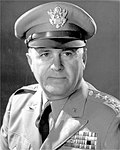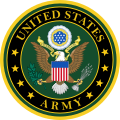| No. | Portrait | Vice Chief of Staff [3] | Took office | Left office | Time in office | Chief of Staff |
|---|
| 1 | | Collins, Joseph LawtonGeneral
J. Lawton Collins
(1896–1987) | November 1, 1948 | August 15, 1949
(became CSA) | 287 days | Omar Bradley |
| 2 | | Haislip, Wade HamptonGeneral
Wade H. Haislip
(1889–1971) | August 16, 1949 | July 29, 1951
(retired) | 1 year, 347 days | J. Lawton Collins |
| 3 | | Hull, John EdwinGeneral
John E. Hull
(1895–1975) | July 30, 1951 | August 14, 1953
(reassigned) | 2 years, 15 days | J. Lawton Collins |
| 4 | | Bolte, Charles LawrenceGeneral
Charles L. Bolte
(1895–1989) | August 15, 1953 | June 29, 1955
(retired) | 1 year, 318 days | Matthew Ridgway |
| 5 | | Palmer, Williston BirkhimerGeneral
Williston B. Palmer
(1899–1973) | June 30, 1955 | May 31, 1957
(reassigned) | 1 year, 335 days | Maxwell D. Taylor |
| 6 | | Lemnitzer, Lyman LouisGeneral
Lyman L. Lemnitzer
(1899–1988) | June 1, 1957 | June 30, 1959
(became CSA) | 2 years, 29 days | Maxwell D. Taylor |
| 7 | | Decker, George HenryGeneral
George H. Decker
(1902–1980) | July 1, 1959 | September 29, 1960
(became CSA) | 1 year, 90 days | Lyman Lemnitzer |
| 8 | | Eddleman, Clyde DavisGeneral
Clyde D. Eddleman
(1902–1992) | September 30, 1960 | March 31, 1962
(retired) | 1 year, 181 days | George Decker |
| 9 | | Hamlett, BarksdaleGeneral
Barksdale Hamlett
(1908–1979) | April 1, 1962 | September 3, 1964
(retired) | 2 years, 155 days | George Decker
Earle Wheeler
Harold K. Johnson |
| 10 | | Abrams, Creighton Williams Jr.General
Creighton W. Abrams Jr.
(1914–1974) | September 4, 1964 | April 30, 1967
(reassigned) | 2 years, 238 days | Harold K. Johnson |
| 11 | | Haines, Ralph Edward Jr.General
Ralph E. Haines Jr.
(1913–2011) | May 1, 1967 | July 2, 1968
(reassigned) | 1 year, 62 days | Harold K. Johnson |
| 12 | | Palmer, Bruce Jr.General
Bruce Palmer Jr.
(1913–2000) | July 3, 1968 | January 4, 1973
(reassigned) | 4 years, 185 days | William Westmoreland
Creighton Abrams |
| 13 | | Haig, AlexanderGeneral
Alexander M. Haig Jr.
(1924–2010) | January 4, 1973 | May 4, 1973
(reassigned) | 120 days | Creighton Abrams |
| 14 | | Weyand, Frederick CarltonGeneral
Frederick C. Weyand
(1916–2010) | May 4, 1973 | October 20, 1974
(became CSA) | 1 year, 169 days | Creighton Abrams
Himself (acting) |
| 15 | | Kerwin, Walter Thomas Jr.General
Walter T. Kerwin Jr.
(1917–2008) | October 21, 1974 | September 23, 1978
(retired) | 3 years, 337 days | Frederick C. Weyand
Bernard W. Rogers |
| 16 | | Kroesen, Frederick James Jr.General
Frederick J. Kroesen
(1923–2020) | October 26, 1978 | October 7, 1979
(reassigned) | 346 days | Bernard W. Rogers
Edward C. Meyer |
| 17 | | Vessey, John William Jr.General
John W. Vessey Jr.
(1922–2016) | October 10, 1979 | January 19, 1982
(became JCS chairman) | 2 years, 101 days | Edward C. Meyer |
| 18 | | Wickham, John Adams Jr.General
John A. Wickham Jr.
(1928–2024) | January 27, 1982 | June 22, 1983
(became CSA) | 1 year, 146 days | Edward C. Meyer |
| 19 | | Thurman, Maxwell ReidGeneral
Maxwell R. Thurman
(1931–1995) | August 26, 1983 | February 4, 1987
(reassigned) | 3 years, 162 days | John A. Wickham Jr. |
| 20 | | Brown, Arthur Edmon Jr.General
Arthur E. Brown Jr.
(born 1929) | February 15, 1987 | January 20, 1989
(retired) | 1 year, 340 days | John A. Wickham Jr.
Carl E. Vuono |
| 21 | | RisCassi, Robert WilliamGeneral
Robert W. RisCassi
(born 1936) | January 21, 1989 | December 10, 1990
(reassigned) | 1 year, 323 days | Carl E. Vuono |
| 22 | | Sullivan, Gordon RussellGeneral
Gordon R. Sullivan
(1937–2024) | December 17, 1990 | June 20, 1991
(became CSA) | 185 days | Carl E. Vuono |
| 23 | | Reimer, Dennis JoeGeneral
Dennis J. Reimer
(born 1939) | June 21, 1991 | January 20, 1993
(reassigned) | 1 year, 213 days | Gordon R. Sullivan |
| 24 | | Peay, James Henry Binford IIIGeneral
J. H. Binford Peay III
(born 1940) | January 23, 1993 | January 15, 1994
(reassigned) | 357 days | Gordon R. Sullivan |
| 25 | | Tilelli, John Harold Jr.General
John H. Tilelli Jr.
(born 1941) | January 20, 1994 | January 2, 1995
(reassigned) | 347 days | Gordon R. Sullivan |
| 26 | | Griffith, Ronald HoustonGeneral
Ronald H. Griffith
(1936–2018) | January 26, 1995 | July 20, 1997
(retired) | 2 years, 175 days | Gordon R. Sullivan
Dennis Reimer |
| 27 | | Crouch, William WrightGeneral
William W. Crouch
(1941–2024) | August 6, 1997 | November 22, 1998
(retired) | 1 year, 108 days | Dennis Reimer |
| 28 | | Shinseki, Eric KenGeneral
Eric K. Shinseki
(born 1942) | November 24, 1998 | June 21, 1999
(became CSA) | 209 days | Dennis Reimer |
| 29 | | Keane, John M.General
John M. Keane
(born 1943) | June 22, 1999 | October 16, 2003
(retired) | 4 years, 116 days | Eric Shinseki
Peter Schoomaker |
| 30 | | Casey, George William Jr.General
George W. Casey Jr.
(born 1948) | October 17, 2003 | July 23, 2004
(reassigned) | 280 days | Peter Schoomaker |
| 31 | | Cody, Richard ArthurGeneral
Richard A. Cody
(born 1950) | July 24, 2004 | July 31, 2008
(retired) | 4 years, 7 days | Peter Schoomaker
George W. Casey Jr. |
| 32 | | Chiarelli, Peter WilliamGeneral
Peter W. Chiarelli
(born 1950) | August 4, 2008 | January 31, 2012
(retired) | 3 years, 180 days | George W. Casey Jr.
Martin Dempsey
Raymond T. Odierno |
| 33 | | Austin, Lloyd James IIIGeneral
Lloyd J. Austin III
(born 1953) | January 31, 2012 | March 8, 2013
(reassigned) | 1 year, 36 days | Raymond T. Odierno |
| 34 | | Campbell, John FrancisGeneral
John F. Campbell
(born 1957) | March 8, 2013 | August 8, 2014
(reassigned) | 1 year, 153 days | Raymond T. Odierno |
| 35 | | Allyn, Daniel BartlettGeneral
Daniel B. Allyn
(born 1959) | August 15, 2014 [4] | June 16, 2017
(retired) | 2 years, 305 days | Raymond T. Odierno
Mark A. Milley |
| 36 | | McConville, James CharlesGeneral
James C. McConville
(born 1959) | June 16, 2017 [5] | July 26, 2019
(became CSA) | 2 years, 40 days | Mark A. Milley |
| 37 | | Martin, Joseph MatthewGeneral
Joseph M. Martin
(born 1962) | July 26, 2019 | August 5, 2022
(retired) | 3 years, 10 days | Mark A. Milley
James C. McConville |
| 38 | | George, Randy AlanGeneral
Randy A. George
(born 1964) | August 5, 2022 [6] | September 21, 2023
(became CSA) | 1 year, 47 days | James C. McConville
Himself (acting) |
| 39 | | Mingus, JamesGeneral
James J. Mingus
(born 1964) | January 5, 2024 [7] | Incumbent | 1 year, 217 days | Randy A. George |














































